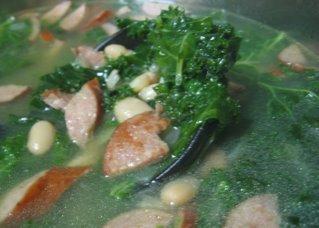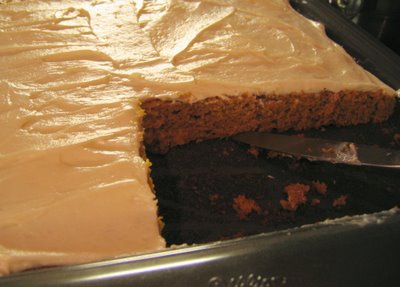 I was so excited to see this recipe and article by Celia Barbour in The New York Times. I'd never seen a crêpe recipe like this printed anywhere (except for this glorious recipe given to me by my brother-in-law's Swiss girlfriend). Don’t Buckwheat Crêpes with a Roasted Cauliflower, Parsnip and Leek filling just sound amazing? I know most Americans aren't avid crêpe makers, but it's about time we joined the club. I knew I had to make this recipe so I could once again push my crêpe agenda on all of you!
I was so excited to see this recipe and article by Celia Barbour in The New York Times. I'd never seen a crêpe recipe like this printed anywhere (except for this glorious recipe given to me by my brother-in-law's Swiss girlfriend). Don’t Buckwheat Crêpes with a Roasted Cauliflower, Parsnip and Leek filling just sound amazing? I know most Americans aren't avid crêpe makers, but it's about time we joined the club. I knew I had to make this recipe so I could once again push my crêpe agenda on all of you! You know how sometimes cooking is a hassle? And how sometimes you're just too tired and grumpy to get any enjoyment out of it? Well, try making these. Crêpe making can be a form of meditation if you think about it. You whip up the simple batter, heat a pan, pour in a ladle-full, smear it around until you've constructed a nice circle, wait, and flip. Repeat. And repeat and repeat. And each one gets better and prettier and you feel more and more proud of yourself. Oh, and you're sipping wine. And with each minute that passes by, you become more comfortable with your now near perfect crêpes and a lot less preoccupied with whatever you were worrying about before you started this whole process. And you swear it's the happiest you've been all week.
This recipe gave me the opportunity to make buckwheat crêpes, or galettes au sarrasin, for the first time. In France, savory buckwheat crêpes like these are always called galettes and the word crêpe is reserved only for sweet crêpes. This recipe was incredibly tasty, but I would have preferred an even stronger buckwheat flavor. You'll probably agree if you've had crêpes in Brittany, but if you are doubtful about buckwheat, this recipe will be a perfect place to begin. It's like a whole wheat crêpe; slightly nutty but with a delicate texture.
The word delicate sums up this roasted cauliflower, leek and parsnip filling as well. I'd never tasted a parsnip, let alone cooked one, so the flavor was such a pleasant surprise. For all the other root-vegetable-dummies out there, parsnips are shaped like carrots, white in color, and have a more delicate flavor, yet a slightly more fibrous texture. They are wonderful! Who knew? Why aren't we eating more parsnips? I'll spare you my embarrassing episode at The Co-op where I almost bought a huge sack full of Daikon radish. Evidently, I needed some help deciphering my root vegetables.
The title of the filling indicates roasted vegetables, which is true, but the really amazing part of the recipe is the custardy sauce in which those veggies take a bath. Honestly, I know you aren't supposed to rave about your own food, but I couldn't wipe the goofy smile from my face when I was eating this. I could go on and on about how the texture of the buckwheat crêpe works so well with the silky and subtle vegetables, but I'll just say this: Hurry up and make these!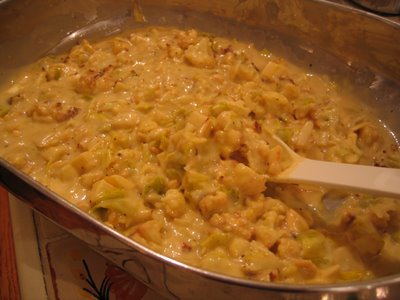 Treat someone you love to this luxurious French meal. You can fill and roll the crêpes if you like, or just serve the warm crêpes and filling separately on platters and let guests make their own. A green salad makes a lovely side. I don't know how anyone could resist the love in this dish. It's an elegant meal that is sure to make anyone feel special.
Treat someone you love to this luxurious French meal. You can fill and roll the crêpes if you like, or just serve the warm crêpes and filling separately on platters and let guests make their own. A green salad makes a lovely side. I don't know how anyone could resist the love in this dish. It's an elegant meal that is sure to make anyone feel special.
*Note* I doubled this recipe since the leftovers are wonderful. If serving 4 or more, I recommend this. However, I had quite a bit of leftover sauce, so no need to double it, more like 1 1/2 times the recipe would work.
Buckwheat Crêpes
½ cup buckwheat flour
½ cup whole wheat flour
½ cup all-purpose white flour
4 eggs
1 tsp salt
1 cup whole milk
2/3 cup water
4 Tbsp melted butter
Melt the butter in a small dish in the microwave or in a saucepan. Set aside to cool slightly.
Stir together the flours and salt. Beat in the eggs and gradually add the milk and water. Whisk the mixture well until completely smooth. Add the butter and whisk until smooth once more. This can also be made in the blender, pulsing for one minute. Refrigerate the batter for one hour. Stir well before using.
Lightly oil or butter a wide skillet or crepe pan and place over high heat. The pan should be almost scorching hot. Lift the skillet from the heat with one hand and pour about 1/3 cup of batter into the pan with the other, all while tilting the pan so that the batter spreads out into a circle. You will need to spread the batter out with a spatula, which feels awkward at first, but after a few times, you'll be quick about it. Put the pan back on the heat and cook 1-2 minutes until the crêpe dries a bit and easily lifts off the bottom of the pan. Flip it over and cook 30 seconds to 1 minute on the other side. Repeat with remaining batter. Makes 12 small crêpes, but I made about 8 large.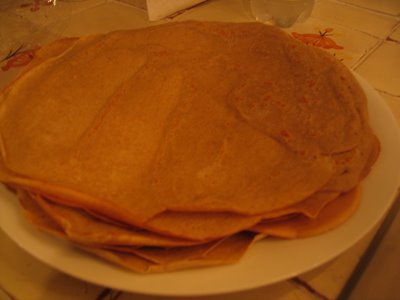
Roasted Cauliflower, Parsnip and Leek Filling
2 lbs cauliflower (about 1 medium), cut into small florets
2 large leeks
¾ lb parsnips (about 3 medium), peeled
5 Tbsp melted butter, divided
1/3 cup olive oil
½ tsp freshly ground pepper
2 tsp dry mustard
2 tsp salt
3 egg yolks
2 Tbsp heavy or light cream, or whole milk
3 cups vegetable or chicken broth
3 Tbsp flour
Preheat the oven to 425 degrees F. In a small bowl, mix together 2 Tbsp melted butter, olive oil, pepper and mustard. (I think 2 Tbsp butter and ¼ cup olive oil is probably plenty, if you’re concerned.) Drizzle about 2/3 of this mixture over the cauliflower florets. Sprinkle with 1 tsp salt. Spread out on a baking sheet and roast for 10 minutes.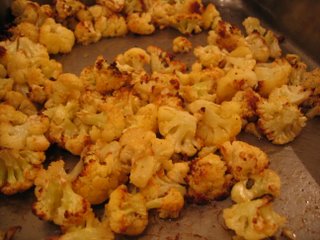
Half the leeks lengthwise, almost to root end, leaving in one piece. Cut the parsnips into quarters lengthwise and remove any tough core, although if you have small parsnips, this is unnecessary. Combine the leeks, parsnips and remaining butter/olive oil mixture and remaining 1 tsp salt. Spread out on a separate baking sheet, or add to the cauliflower pan if there is room. Return vegetables to the oven and roast for 20 minutes. Reduce the heat to 325 degrees F and roast until golden and tender, another 20-30 minutes.
Transfer leeks and parsnips to a cutting board and chop into ½ inch pieces. You can chop the cauliflower, too, but mine seemed like a fine size already. Set aside.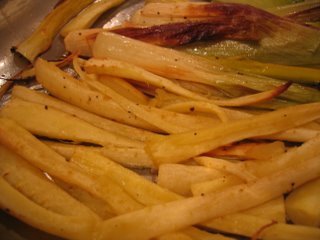
In a mixing bowl, combine the egg yolks and cream. In a small saucepan, bring the broth to a simmer. In different saucepan, whisk together the remaining 3 Tbsp melted butter and the flour. Stir and cook for 2-3 minutes but do not brown. Gradually whisk in the broth until incorporated and the sauce is smooth. Bring to a simmer over medium heat and let the sauce thicken.
Take off the heat for a few minutes, then whisk very gradually into the bowl with the egg yolks and cream. Do this slowly so that the egg yolks don’t scramble! Once all the broth mixture is added to the egg yolks, return all of it to the saucepan and keep over medium heat; do not boil. Add the vegetables to this sauce and keep warm.
Assemble the crêpes yourself, or pour the vegetables and sauce onto a deep platter so that guests can make their own. Sprinkle with chopped fresh parsley to garnish. (If assembling ahead of time, reserve some of the sauce sans vegetables to top the finished crêpes.) Place about 1/3 cup filling into each crêpe and roll up burrito-style. Place the filled crêpes in a baking dish. Cover with a bit of the reserved sauce and bake for 15-20 minutes at 350 degrees F, or until warmed through.
 This is a wonderful appetizer that I served for Thanksgiving this year. It's extremely easy yet really impressive. So, in other words, it's exactly what you want when you're preparing so much other food for a huge meal!
This is a wonderful appetizer that I served for Thanksgiving this year. It's extremely easy yet really impressive. So, in other words, it's exactly what you want when you're preparing so much other food for a huge meal!








